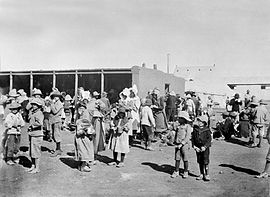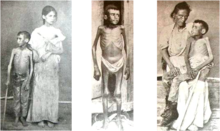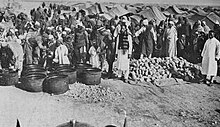Concentration camp

A concentration camp is a form of internment camp for confining political prisoners or politically targeted demographics, such as members of national or minority ethnic groups, on the grounds of state security, or for exploitation or punishment.[1] Prominent examples of historic concentration camps include the British confinement of non-combatants during the Second Boer War, the mass internment of Japanese-American citizens by the US during the Second World War, the Nazi concentration camps, which later morphed into extermination camps, and the Soviet labour camps or gulag.[1]
History
The term concentration camp originates from the Spanish–Cuban Ten Years' War when Spanish forces detained Cuban civilians in camps in order to more easily combat guerrilla forces. Over the following decades the British during the Second Boer War and the Americans during the Philippine–American War also used concentration camps.
The term "concentration camp" and "internment camp" are used to refer to a variety of systems that greatly differ in their severity, mortality rate, and architecture; their defining characteristic is that inmates are held outside the rule of law.[2] Extermination camps or death camps, whose primary purpose is killing, are also imprecisely referred to as "concentration camps".[3]




The American Heritage Dictionary defines the term concentration camp as: "A camp where persons are confined, usually without hearings and typically under harsh conditions, often as a result of their membership in a group which the government has identified as dangerous or undesirable."[4]
Although the first example of civilian internment may date as far back as the 1830s,[5] the English term concentration camp was first used in order to refer to the reconcentration camps (Spanish:reconcentrados) which were set up by the Spanish military in Cuba during the Ten Years' War (1868–1878).[6][7] The label was applied yet again to camps set up by the United States during the Philippine–American War (1899–1902).[8] And expanded usage of the concentration camp label continued, when the British set up camps during the Second Boer War (1899–1902) in South Africa for interning Boers during the same time period.[6][9]
During the 20th century, the arbitrary internment of civilians by the state reached its most extreme forms in the Soviet Gulag system of concentration camps (1918–1991)[10] and the Nazi concentration camps (1933–1945). The Soviet system was the first applied by a government on its own citizens.[7] The Gulag consisted in over 30,000 camps for most of its existence (1918–1991) and detained some 18 million from 1929 until 1953,[10] which is only a third of its 73-year lifespan. The Nazi concentration camp system was extensive, with as many as 15,000 camps[11] and at least 715,000 simultaneous internees.[12] The total number of casualties in these camps is difficult to determine, but the deliberate policy of extermination through labor in many of the camps was designed to ensure that the inmates would die of starvation, untreated disease and summary executions within set periods of time.[13] Moreover, Nazi Germany established six extermination camps, specifically designed to kill millions of people, primarily by gassing.[14][15]
As a result, the term "concentration camp" is sometimes conflated with the concept of an "extermination camp" and historians debate whether the term "concentration camp" or the term "internment camp" should be used to describe other examples of civilian internment.[16]
The former label continues to see expanded use for cases post-World War II, for instance in relation to British camps in Kenya during the Mau Mau rebellion (1952–1960),[17][18] and camps set up in Chile during the military dictatorship of Augusto Pinochet (1973–1990).[19] According to the United States Department of Defense as many as 3 million Uyghurs and members of other Muslim minority groups are being held in China's re-education camps which are located in the Xinjiang region and which American news reports often label as concentration camps.[20][21] The camps were established in the late 2010s under General Secretary Xi Jinping's administration.[22][23]
See also
- List of concentration and internment camps
- Second Boer War concentration camps (1900–1902)
- Herero and Namaqua genocide (1904–1907)
- Italian concentration camps in Africa and Europe (1930–1944)
- German concentration camps before and during World War II (1933–1945)
- Japanese internment of prisoners of war and civilians during World War II (ended 1945)
- Japanese-American internment camps in World War II (1942–1946)
- Japanese Canadian internment (1942–1949)
- Civilian internee
- Extermination through labor
- Gulag
- New village
- Bantustan
- Labor camp
- Kwalliso (North Korean political penal labour colonies)
- Laogai (Chinese, "reform through labor")
- "Polish death camp" controversy
- Prisoner-of-war camp
- Prisons in North Korea
- Re-education camp (Vietnam)
- Re-education through labor
References
- ^ a b "Concentration camp | Facts, History, Maps, & Definition | Britannica". www.britannica.com.
- ^ Stone, Dan (2015). Concentration Camps: A Very Short Introduction. Oxford University Press. pp. 122–123. ISBN 978-0-19-879070-9.
Concentration camps throughout the twentieth and twenty-first centuries are by no means all the same, with respect either to the degree of violence that characterizes them or the extent to which their inmates are abandoned by the authorities... The crucial characteristic of a concentration camp is not whether it has barbed wire, fences, or watchtowers; it is, rather, the gathering of civilians, defined by a regime as de facto 'enemies', in order to hold them against their will without charge in a place where the rule of law has been suspended.
- ^ "Nazi Camps". United States Holocaust Memorial Museum. Retrieved 3 October 2020.
- ^ "Concentration camp". American Heritage Dictionary. Retrieved 22 July 2014.
- ^ James L. Dickerson (2010). Inside America's Concentration Camps: Two Centuries of Internment and Torture. Chicago Review Press. p. 29. ISBN 978-1-55652-806-4.
- ^ a b The Columbia Encyclopedia: Concentration Camp (Sixth ed.). Columbia University Press. 2008.
- ^ a b "Concentration Camps Existed Long Before Auschwitz". Smithsonian. 2 November 2017.
- ^ Storey, Moorfield; Codman, Julian (1902). Secretary Root's record. "Marked severities" in Philippine warfare. An analysis of the law and facts bearing on the action and utterances of President Roosevelt and Secretary Root. Boston: George H. Ellis Company. pp. 89–95.
- ^ "Documents re camps in Boer War". sul.stanford.edu. Archived from the original on 9 June 2007.
- ^ a b "Gulag: A History, by Anne Applebaum (Doubleday)". The Pulitzer Prizes. 2004. Retrieved 2019-11-13.
- ^ "Concentration Camp Listing". Belgium: Editions Kritak.
Sourced from Van Eck, Ludo Le livre des Camps
and Gilbert, Martin (1993). Atlas of the Holocaust. New York: William Morrow. ISBN 0-688-12364-3.. In this online site are the names of 149 camps and 814 subcamps, organized by country. - ^ Evans, Richard J. (2005). The Third Reich in Power. New York: Penguin Group. ISBN 978-0-14-303790-3.
- ^ Marek Przybyszewski. IBH Opracowania – Działdowo jako centrum administracyjne ziemi sasińskiej [Działdowo as the centre of local administration] (in Polish). Archived from the original on 2010-10-22 – via Internet Archive.
- ^ Robert Gellately; Nathan Stoltzfus (2001). Social Outsiders in Nazi Germany. Princeton University Press. p. 216. ISBN 978-0-691-08684-2.
- ^ Anne Applebaum (18 October 2001). "A History of Horror| Review of Le Siècle des camps by Joël Kotek and Pierre Rigoulot". The New York Review of Books.
- ^ Schumacher-Matos, Edward; Grisham, Lori (10 February 2012). "Euphemisms, Concentration Camps And The Japanese Internment". npr.org.
- ^ "Museum of British Colonialism releases online 3D models of British concentration camps in Kenya". Morning Star. 27 August 2019.
- ^ "The Mau Mau Rebellion". The Washington Post. 31 December 1989.
- ^ "Chilean coup: 40 years ago I watched Pinochet crush a democratic dream". The Guardian. 7 September 2013.
- ^ "As the U.S. Targets China's 'Concentration Camps', Xinjiang's Human Rights Crisis is Only Getting Worse". Newsweek. 22 May 2019.
- ^ "Uighurs and their supporters decry Chinese 'concentration camps', 'genocide' after Xinjiang documents leaked". The Washington Post. 17 November 2019.
- ^ Ramzy, Austin; Buckley, Chris (2019-11-16). "'Absolutely No Mercy': Leaked Files Expose How China Organized Mass Detentions of Muslims". The New York Times. ISSN 0362-4331. Retrieved 2019-11-16.
- ^ Kate O'Keeffe and Katy Stech Ferek (14 November 2019). "Stop Calling China's Xi Jinping 'President', U.S. Panel Says". The Wall Street Journal.
Further reading
- Pitzer, Andrea (2017). One Long Night: A Global History of Concentration Camps. Little, Brown and Company. ISBN 978-0-316-30359-0.
- Stone, Dan (2015). Concentration Camps: A Very Short Introduction. Oxford University Press. ISBN 978-0-19-879070-9.
- Smith, Iain R.; Stucki, Andreas (September 2011). "The Colonial Development of Concentration Camps (1868–1902)" (PDF). The Journal of Imperial and Commonwealth History. 39 (3): 417–437. doi:10.1080/03086534.2011.598746. S2CID 159576119.
External links
 Media related to Concentration camps at Wikimedia Commons
Media related to Concentration camps at Wikimedia Commons
